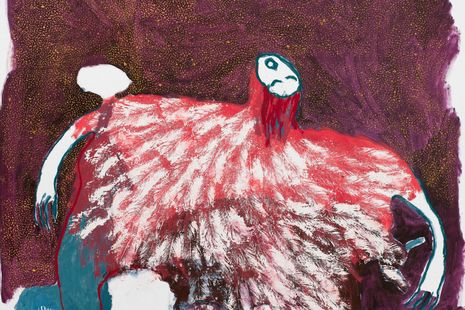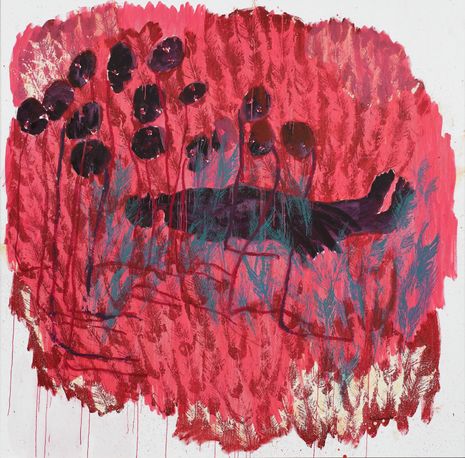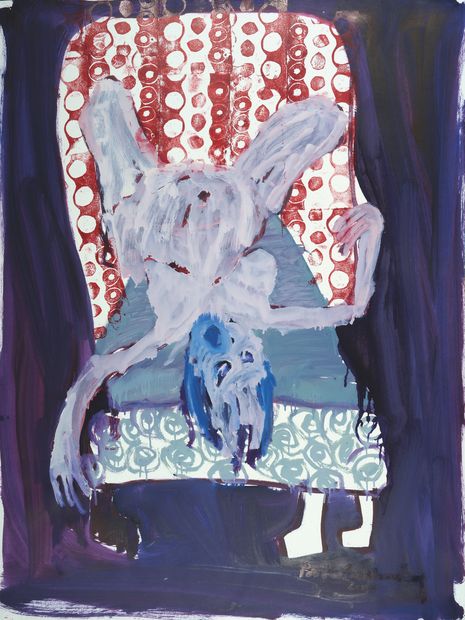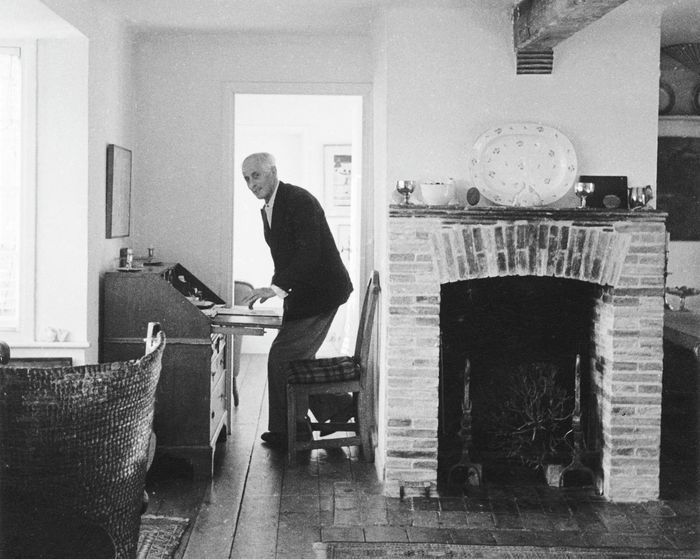Portia Zvavahera: enchanting dream visions
The Zimbabwean artist’s Kettle’s Yard exhibition, ‘Zvakazarurwa’, weaves fantasy imagery with reflections on motherhood in her first solo European show

“As I’m sleeping, I see things,” says Zimbabwean artist Portia Zvavahera. With ‘Zvakazarurwa’ at Kettle’s Yard, her first solo public exhibition in Europe, we see those things too. Drawing on dream visions, her Christian faith, and the spiritual traditions she encountered as a child, the exhibition explores the beauty and truth which can be found by engaging with affective experience.
“Intricate patterns impose detail and order onto swirling, dramatic scenes”
Fantasy and experience, thought and emotion, day and night, come together in Zvavahera’s striking images. The title, translated from Shona as ‘Revelations’, reveals Zvavahera’s openness to the dreaming world as a source of meaning. Demonic, red-eyed rats scurry across large, deep-red canvases in one room, housing a series of work created in response to one dream, while a second room, composed of Zvavahera’s earlier work, collects the artist’s responses to childbirth and motherhood.
The dream pieces are hugely engrossing; their largely limited palette of reds and purples arrests the eye, as do the intricate patterns that swim among these dark tones. Each piece offers a different response to a nightmare experienced by the artist, in which demonic rats threatened the safety of her loved ones. But, despite their ghoulish quality and burning eyes, Zvavahera doesn’t condemn these rats. Rather, she engages with them, submitting them to interrogation and experimentation. Although the rats dominate the first, and largest, artwork in the room, huge and shadowy, in another work they are tiny, captured within the arms of an angel-like figure, while in another they seem almost benevolent, their ragged purple fur replaced with a beautiful blue pattern.

Each of Zvavahera’s pieces combine various techniques and processes, but most affecting is her use of printing: repeated, intricate patterns impose detail and order onto swirling, dramatic scenes. These printed motifs lend a familiarity to the surreal dream imagery which emphasises the significance of the emotions and messages encoded in the scenes. The recognition of a lace pattern here, a feather pattern there establishes an important anchorage between the dreaming and waking worlds.
Most striking in these dreamscapes are the expanses of blank space which Zvavahera leaves on her canvases. These fields of white sometimes push in from the edges of the frame, perhaps a manifestation of waking logic, pushing against the subjectivity of the dream imagery and its memory. But, in other works, these white spaces open up within the canvas, pushing out from the middle, pushing away the intense colour and pattern that otherwise seems innate to Zvavahera’s work. In one of the dreamscape pieces, these areas of negative space form characters of their own, the shapes teasing between humanoid and angelic imagery.
“‘Zvakazarurwa’ offers emotive responses to childbirth, love, loss, and pain”
In a recorded interview included in the exhibition, Zvavahera says that she leaves blank space in her artworks “so it can be filled by a higher power”. The artist’s faith, and its centrality to her modes of creativity, is a key theme of the exhibition. Its curator, Tamar Garb, an Art History professor at University College London, describes the initial difficulty she felt in setting aside her secular worldview in order to engage with the religious expression which is fundamental to Zvavahera’s work.
The artist’s masterful incorporation of printed patterns into her paintings is even more apparent in her earlier work. Both ‘Ndahwarara’ and ‘Ndokumbriawo Ishe’ feature prone female figures, heads turned to the ground in apparent anguish. But, where the women’s bodies should be, perhaps painted in the same large, contorting brush strokes as elsewhere, are instead calming printed patterns of blue and green, which both ease and transfix the eye.

This technique is used again in Zvavahera’s ‘Labour Pains,’ which depicts a mother in childbirth: eyes wide open, mouth agape, limbs flailing. The piece doesn’t shy away from the painful labour of childbirth, fulfilling the promise made in its title. While printing offered a calm, ordering presence to ‘Ndahwarara’ and ‘Ndokumbriawo Ishe’, the pattern here is far more loosely applied: a blue swirling pattern careens off of the bed frame at the bottom of the painting, while red printed circles get lost in dark blues and purples higher up.
Placed to the right of this piece is ‘Labour Ward’, painted in the same year, containing three expectant mothers who, while clearly still in pain, seem buoyed by their solidarity, which is illustrated by their harmonious blue shades. ‘His Presence’ also depicts a group of women engaging in a shared experience. With each figure identically posed, on their knees and with their arms outstretched, Zvavahera portrays prayer as a physically demanding, yet rewarding, phenomena, with clear visual similarities to the artist’s depiction of childbirth.
Imaginatively charged and visually transfixing, ‘Zvakazarurwa’ offers emotive responses to childbirth, love, loss, and pain, enabled by its breadth of imagery and technique. Zvavahera’s approach towards narrative is central to the exhibition’s success. Approaching a room filled with paintings with ostensibly the same point of origin, a viewer is treated with a unique experience. As the gallery offers no indication of sequence or narrative between the artworks, the pieces are presented as differing, yet equal, interpretations of Zvavahera’s sleeping world.
Zvakazarurwa is at Kettle’s Yard, Cambridge, until the 16th of February 2025.
 News / Eight Cambridge researchers awarded €17m in ERC research grants27 December 2025
News / Eight Cambridge researchers awarded €17m in ERC research grants27 December 2025 News / Downing investigates ‘mysterious’ underground burial vault 29 December 2025
News / Downing investigates ‘mysterious’ underground burial vault 29 December 2025 Lifestyle / Ask Auntie Alice29 December 2025
Lifestyle / Ask Auntie Alice29 December 2025 Sport / Hard work, heartbreak and hope: international gymnast Maddie Marshall’s journey 29 December 2025
Sport / Hard work, heartbreak and hope: international gymnast Maddie Marshall’s journey 29 December 2025 Interviews / Meet Juan Michel, Cambridge’s multilingual musician29 December 2025
Interviews / Meet Juan Michel, Cambridge’s multilingual musician29 December 2025










